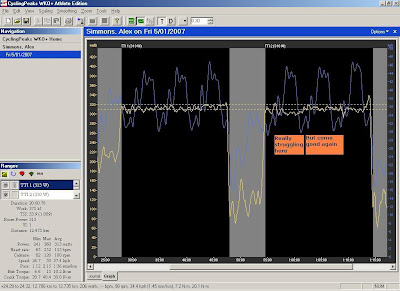Surfing the Pain Curve
On many cycle training forums and in several training articles or books you might see reference to a type of training workout acknowledged as being most useful in helping to increase one's Functional Threshold Power (FTP) - the maximal power output sustainable for about an hour (usually attainable when not overly fatigued). Sometimes these are called Time Trial workouts.
FTP is a pretty important fitness marker, especially since it is readily testable by anyone using a power meter, but mainly because it is the single most important physiological determinant of performance in aerobic events from 3km individual pursuits to grand tours.1
Everyone has an FTP of course, we just may not know what it is (FTP is determined via testing or actual race performance), or it may not be as high as we'd like (is it ever?).Of course there are other important attributes necessary for cycling performance and they cannot be ignored - undertaking training specific to your event is critical. That said, improving your FTP will go a long, long way towards improving performance. Hence why cyclists like me want to improve their FTP.
So we do what (legally) works best - Level 4 workouts (Level 4 as defined by Andy Coggan's training levels). These Level 4 (L4) workouts commonly involve efforts of between 10 and 30 minutes duration at an average power ranging between 91% and 105% of your current FTP. Often, more than one interval is performed with a short period, say 5 to 10 minutes, of easy riding in between. Apart from the duration of each interval (and the number of intervals), the next factor to consider is the intensity at which to ride them.
Other training schemas refer to them as Time Trial Intervals, or 60 minute Critical Power efforts (CP60). All are similar in concept and serve to induce the same physiological adaptation - namely improved FTP.
2 x 20sA commonly used L4 workout is the "2 x 20", meaning two intervals of 20 minutes each. There is a big difference between riding these efforts at 91% of FTP to riding them at 105% of FTP. Typically there is a trade off between intensity and duration, depending on where you are in your training cycle, the composition of your total training, current levels of fatigue etc. Riding in the 91%-95% range means you could do more of these efforts (or more frequently) than if you perform them at 100%-105% of your FTP.
At the moment, part of my training involves doing these 2x20s at and just above FTP (100%-103% of FTP). Hence, in the context of the routine of other fatigue inducing training, these are quite tough to do.
So tough in fact that last week I was unable to complete the 2nd interval. This week however, I managed, just, to get through. Here's a pic of the workout from Cycling Peaks (click/right click to view larger image).
For me this was a breakthrough as (aside from racing) I hadn't ridden L4 efforts at this power level before (I'm currently at PB power levels). I had done L4 work before, sometimes with a twist involving L5/L6 efforts but not at this average power.
Effort #2 was particularly hard - if you look at the power line (the yellow line) you can see how just a few minutes into the effort I was struggling to maintain power within the set range (marked with the horizontal dashed lines). But somehow I managed to convince myself to keep trying and for some reason I can't quite explain, a few minutes later I seemed to improve and once I got past halfway, I knew I could make it the whole way. I just managed to complete the set within the desired power band.
It certainly showed me it is possible to surf the pain curve, sometimes you just need to use a bit of positive affirmation when the legs are really suffering.....1. Training & Racing with a Power Meter, Allen & Coggan, pp 43-44.




7 comments:
if you don't mind me asking... how much do you weigh?
Not at all but I do like people to leave a name!
I'm currently 80kg, so no flyweight. According to Andy Coggan's power profile chart, that puts my FTP at the bottom end of Cat 3.
sounds like a great workout. Is that the Olympic park route? Must be some hills in there.
rick
Hi Rick
Centennial Park, Sydney, is where I typically do these types of efforts (including this one). The 3.78km roughly circular circuit of Grand Drive has an elevation variance of approx 15-16 metres, with one other "dip and rise" of a few metres. That, along with whatever the prevailing wind is up to, make the speed variance quite substantial when doing isopower type efforts.
It's about another 28 metre rise to the Ocean Street gates if you choose to do some efforts up the hill.
Grand Dr is a good option as there are no stoppages required anywhere on the circuit, especially as I live in a big city and long uninterrupted stretches of road are rare. If unlucky, an overzealous ranger at 6.30am may not like the speed you are riding but usually they focus on the larger groups travelling at speed.
Did you mostly do these 2x20s outside or on a trainer?
Which would you suggest? I personally prefer riding outside and loathe the trainer but London offers little in the way of traffic free, junction free training routes.
I used to only do them outside but now I have my indoor training arrangemnt set up, I mix them up between outdoors and indoors. Search for "Thunderbird 7" and you see my trainer.
fyi...coggans training power levels have moved: http://home.trainingpeaks.com/blog/article/power-training-levels
Post a Comment